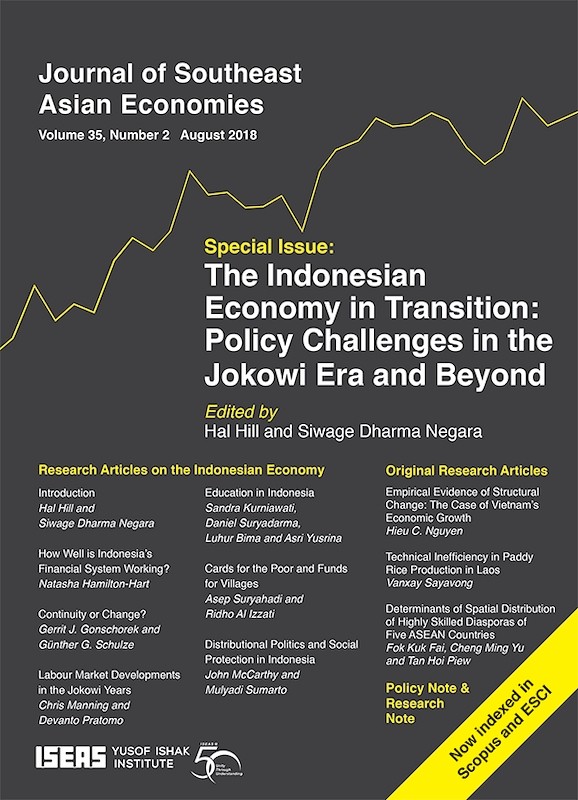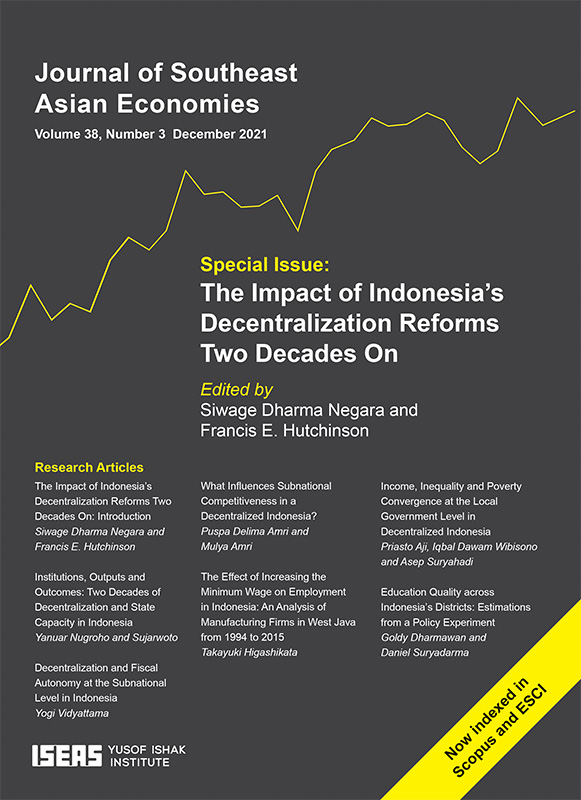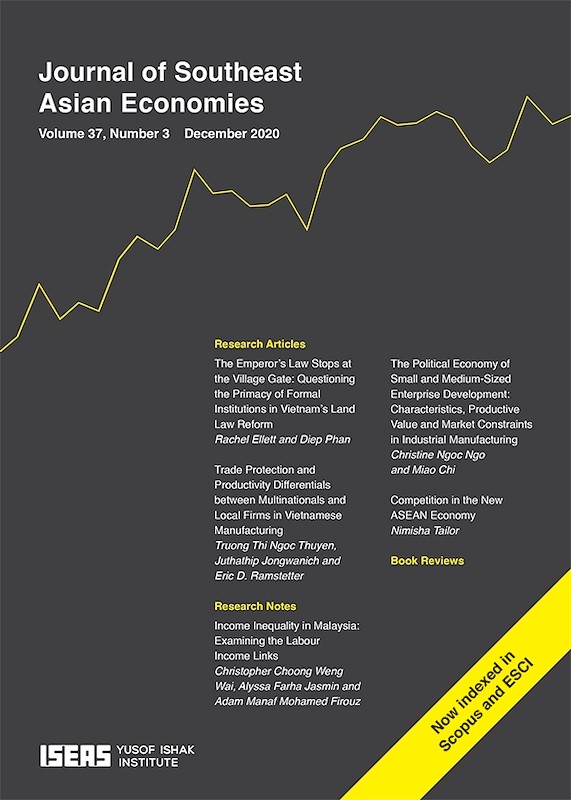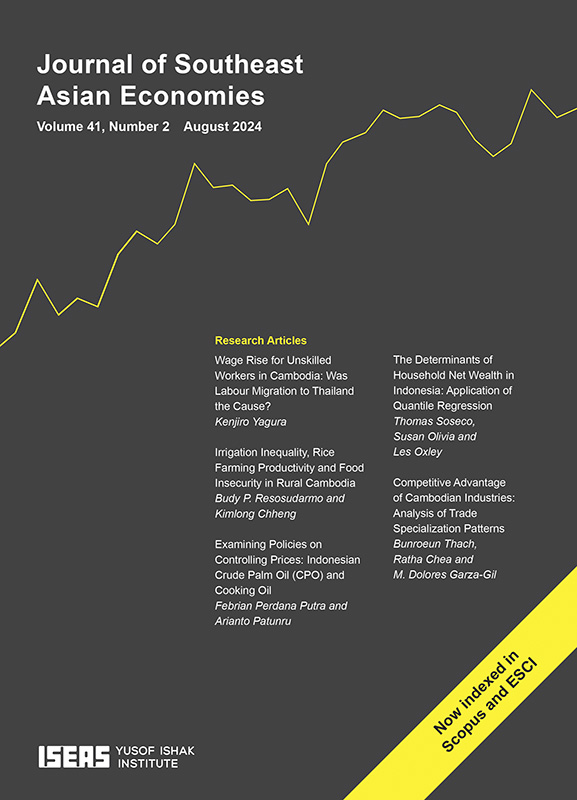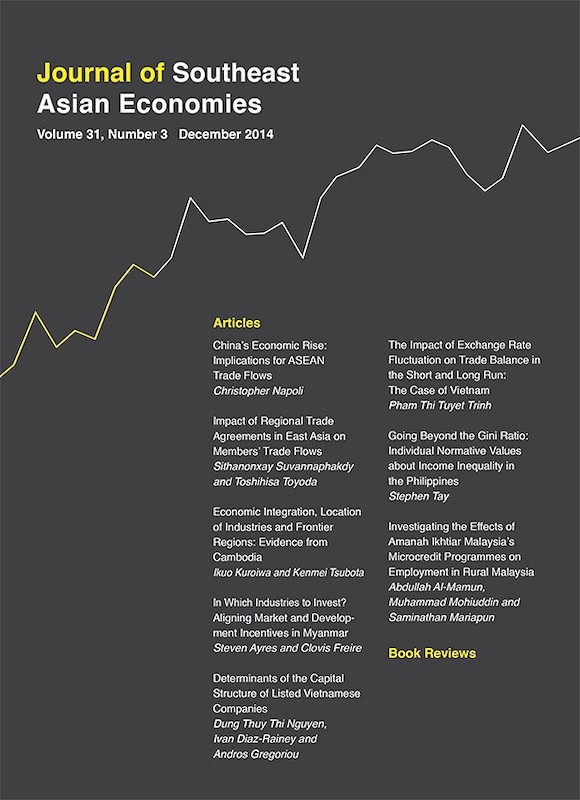Journal of Southeast Asian Economies Vol. 36/3 (Dec 2019). Special focus on "Inequality and Exclusion in Southeast Asia"
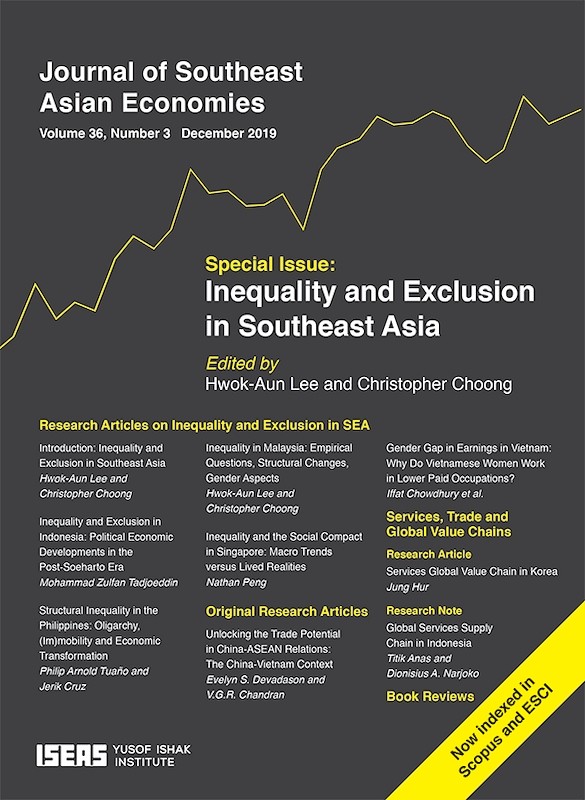
Date of publication:
December 2019
Publisher:
ISEAS – Yusof Ishak Institute
Number of pages:
200
Code:
AE36/3
Contents
-
Journal of Southeast Asian Economies Vol. 36/3 (Dec 2019). Special focus on "Inequality and Exclusion in Southeast Asia"
[Whole Publication, ISSN: 23395206] -
Preliminary pages
- RESEARCH ARTICLES ON "INEQUALITY AND EXCLUSION IN SOUTHEAST ASIA"
-
Introduction: Inequality and Exclusion in Southeast Asia, by Lee Hwok-Aun, Christopher Choong, authors
-
Inequality and Exclusion in Indonesia: Political Economic Developments in the Post-Soeharto Era, by Mohammad Zulfan Tadjoeddin, author see abstractThis paper reviews the long-term trend of economic inequality and exclusion in Indonesia since the country embarked on its democratic transition in the late 1990s. While economic inequality was largely stable and relatively low during the high-growth New Order phase that lasted from the 1970s until the 1990s, it sharply increased during the first decade of the new millennium, reaching a record high in 2011 when the expenditure Gini coefficient touched 0.41. The Gini has started to decline since 2015, albeit slowly. Using earnings data from the labour force survey, six sources of exclusion are identified, including: belonging to the lower income group; low educational attainment; residing in a rural area; working in the informal sector; being female; and having a disability. In general, there has been no meaningful trend of inclusion for the identified groups relative to the reference groups. While Indonesia has placed more serious attention on tackling rising inequality, particularly by expanding infrastructure, connectivity and social assistance, policymakers need to start efficiently targeting those categorized as disadvantaged groups.
-
Structural Inequality in the Philippines: Oligarchy, (Im)mobility and Economic Transformation, by Philip Arnold P Tuano, Jerik Cruz, authors see abstractOver the past four decades, the Philippines has achieved significant advances in its growth performance and has undergone a series of transformations in its political, economic and social structures. However, while average incomes have risen, the country’s record in terms of generating quality employment and reducing poverty and inequality has been disappointing. High levels of income inequality and social exclusion have persisted in the country, even as the rate of upward socio-economic mobility, at least compared to its ASEAN neighbours, has been low. Moreover, new evidence suggests that key forms of wealth inequality have been rising. These trends are caused not only by poor human and physical investment as well as the adverse effects of premature deindustrialization, but also by the dynamics of an oligarchical political economy in which political dynasties and family-linked conglomerates have substantially curbed the capacity of non-elite formations and players to assert more developmental policy regimes and substantive democratization.
-
Inequality in Malaysia: Empirical Questions, Structural Changes, Gender Aspects, by Lee Hwok Aun, Christopher Choong, authors see abstractMalaysia has consistently placed high priority on reducing income inequality, particularly between ethnic groups, with increasing emphasis in recent years on national—rather than intergroup—inequality, exclusion of low-income households, and gender disparity. Official statistics show steeply declining household income inequality in recent years, and a marginal gender wage gap, but further investigation finds different trends and more nuanced pictures. This paper presents alternative findings that pose questions about the official account. Computing estimates of wage distribution, the study finds moderate changes in inequality, with relatively higher wage growth at the top and bottom ends—managers, production and elementary workers—while professionals, skilled workers and service workers have experienced slower gains. Shifts in Malaysia’s economic structure and labour markets are consistent with the modest changes in inequality that are observed, and somewhat confound the drastic drop plotted in official sources. On gender inequality, women’s rapidly increased educational attainment and steadily rising labour participation have bolstered their economic standing, and may account for the surprisingly low average male-female wage disparity. However, when disaggregated by occupation, age group, and employment status, substantial gender gaps are observed. Malaysia’s efforts to redress inequality warrant more rigorous analyses and systematic policies.
-
Inequality and the Social Compact in Singapore: Macro Trends versus Lived Realities, by Nathan Peng, author see abstractThis paper provides an overview of Singapore’s inequality since 2000. Upon examining empirical indicators reflecting different aspects of inequality, there seems to be a divergence between largely stable macro-level trends and “felt” inequality experienced by citizens. While the empirical record reflects fairly stable income, wealth, consumption and intergenerational inequality, other data show how educational performance and sense of belonging are continuously tied to socio-economic position. Juxtaposing these insights against a qualitative analysis of Singapore’s meritocracy, the social and political ferment on the issue of inequality in 2018—with heightened discourses among both elites and the public—makes sense against a backdrop of lived realities having become increasingly devolved from promises of equal opportunities. Typifying Singapore as a “pragmatic meritocracy” where systemic inequalities are recognized and addressed, the paper reviews policy responses to the rising discontent, and elaborates on the seeming disconnect between government narratives and generally incrementalistic solutions.
- ORIGINAL RESEARCH ARTICLES
-
Unlocking the Trade Potential in China-ASEAN Relations: The China-Vietnam Context, by Evelyn S. Devadason, VGR Chandran, authors see abstractThe China-ASEAN trade relationship is multidimensional. The trade situation between China and Vietnam is not similar to that of China and the ASEAN-5, as the former records trade surpluses with Vietnam in agriculture and manufactures. Bilaterally, China’s exports are also more homogeneously distributed relative to Vietnam, and comprise higher value-added intermediates. Despite the asymmetry in terms of economic capacity between China and Vietnam, it is not one-sided nor is it all downside, as there is a high level of economic interdependence between the two. The empirical results from the stochastic frontier analysis indicate that Vietnam’s trade efficiency scores with China are somewhat comparable with the efficiency levels achieved by the other ASEAN members in trade with China. Importantly, Vietnam’s exports of agriculture products to China are operating closer to their potential level than China’s exports to Vietnam. Overall, there remains scope for improving export efficiency in the China-Vietnam partnership. It is therefore untrue to assume that only the larger side could get more from this relationship.
-
Gender Gap in Earnings in Vietnam: Why Do Vietnamese Women Work in Lower Paid Occupations?, by Iffat Chowdhury, Hillary C. Johnson , Aneesh Mannava , Elizaveta Perova , authors see abstractDifferences in earnings between male and female workers persist in developed and developing countries despite a narrowing of gaps in educational attainment. This paper examines the gender wage gap in Vietnam and shows that a non-trivial part of the gap is associated with occupational sorting. The study considers three explanations for why occupational sorting emerges. First, data from Labour Force Surveys support the hypothesis that women sort into occupations with better non-monetary characteristics, such as paid leave and shorter hours. Second, the findings do not support the hypothesis of occupational sorting among the adult labour force as being driven by social norms about gender roles learned at an early age. Specifically, the analysis simulates what the gender wage gap would be if children pursued the occupations they aspired for at the age of twelve, and the distribution of salaries remained unchanged. Finally, there is no evidence to support the claim that individuals with higher education sort during the school-to-work transition, when women face higher barriers in finding a job in their field of study. Overall, the findings suggest that, in Vietnam gender-specific preferences for non-monetary job characteristics play a key role in the emergence of occupational sorting.
- RESEARCH ARTICLE ON “SERVICES, TRADE AND GLOBAL VALUE CHAINS”
-
Services Global Value Chain in Korea, by Jung Hur, author see abstractThis paper examines the services global value chain activities in Korea using the TiVA (Trade in Value-Added) database and firm-level data. The results indicate that Korea’s services sector has been expanding gradually, with its value-added share increasing from nearly 50 per cent during the 1990s to 60 per cent in the 2010s. Another major finding is the noticeable rise in the employment share of the services sector over the last few years. Furthermore, firm-level analysis shows that Korean firms with service affiliates in foreign countries perform much better in terms of productivity and employment as compared to those without such affiliates.
- RESEARCH NOTE ON “SERVICES, TRADE AND GLOBAL VALUE CHAINS”
-
Global Services Supply Chain in Indonesia: The Case of Telecommunications Services, by Titik Anas, Dionisius Ardiyanto Narjoko, authors see abstractThis paper examines services sector liberalization and global production value chains in Indonesia, particularly focusing on the telecommunications sector. The study employs TiVA, Indonesia’s Input Output (I-O) Tables and sectoral-level data for analysis, as firm-level data is not available for Indonesia’s services sector. The value chain for the telecommunications services is also mapped to depict not just its contribution to the manufacturing sector, but also its importance for the overall growth of the economy. In addition, the paper delves into the regulatory framework governing the sector and the measures that can be taken to boost its progress.
- BOOK REVIEWS
-
BOOK REVIEW: Indonesia: Twenty Years of Democracy (Elements in Politics and Society in Southeast Asia), by Jamie Davidson., by Deasy Simandjuntak, author
-
BOOK REVIEW: Authoritarian Capitalism: Sovereign Wealth Funds and State-Owned Enterprise in East Asia and Beyond, by Richard W. Carney., by Mohammad Syafiq Suhaini, author

